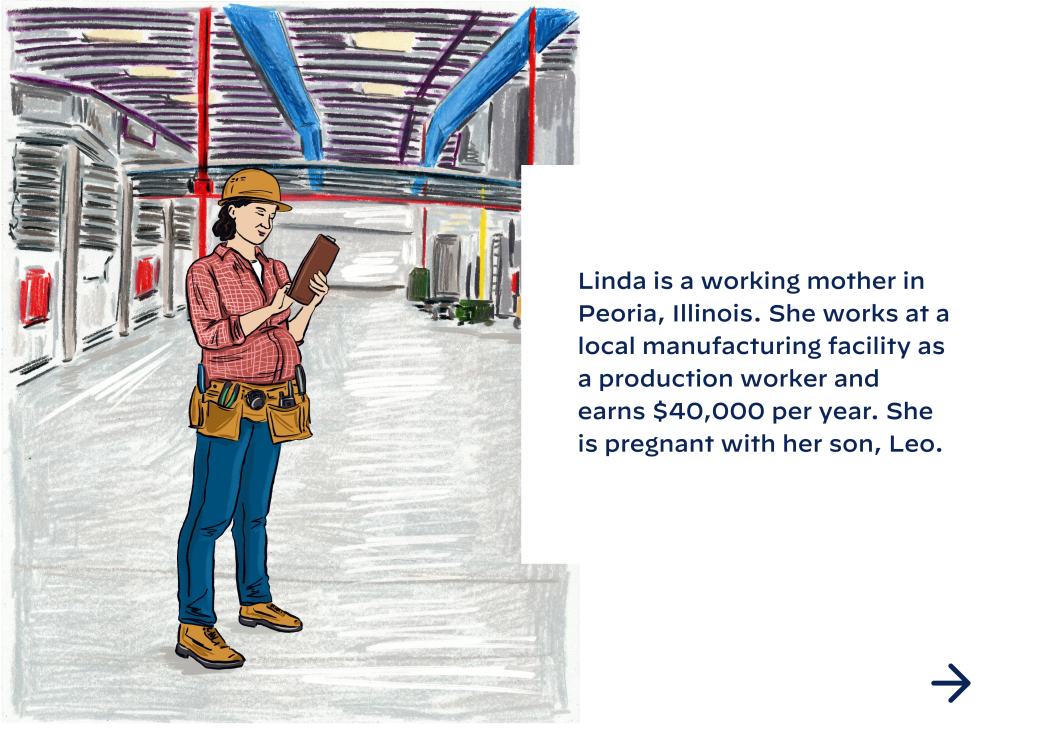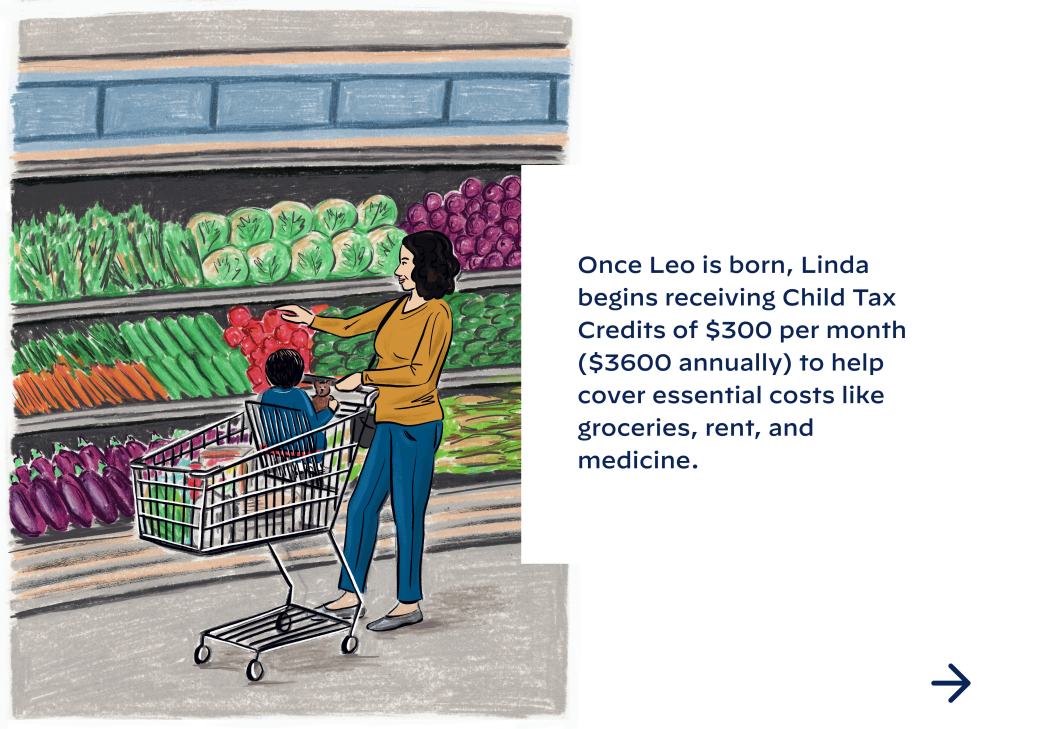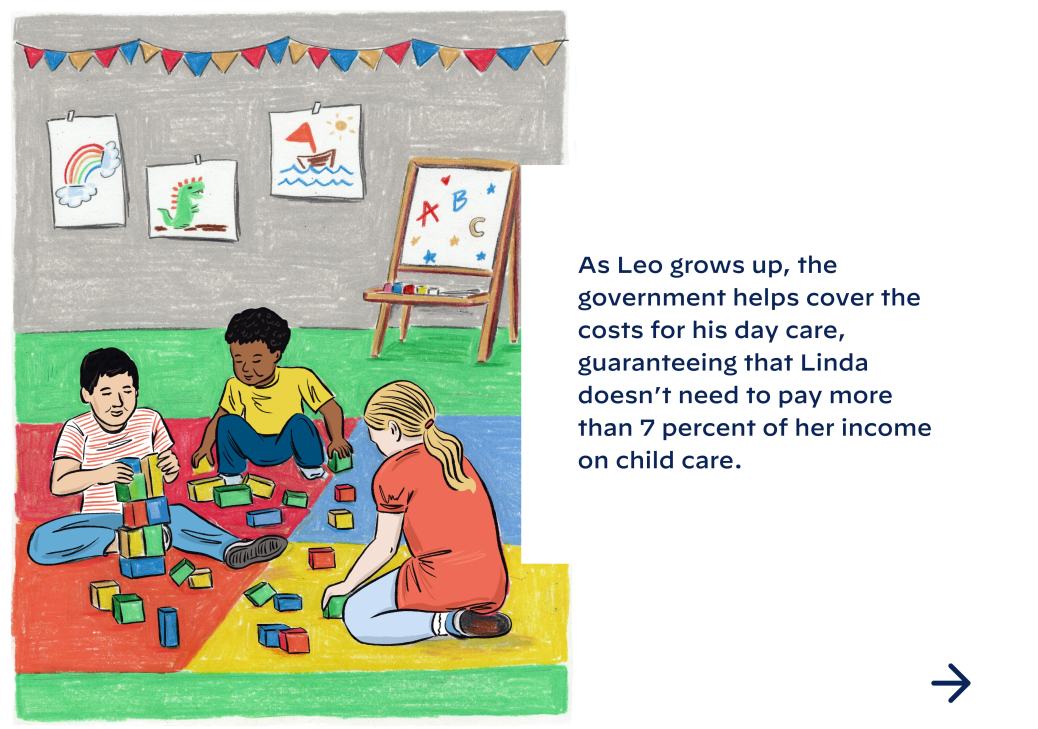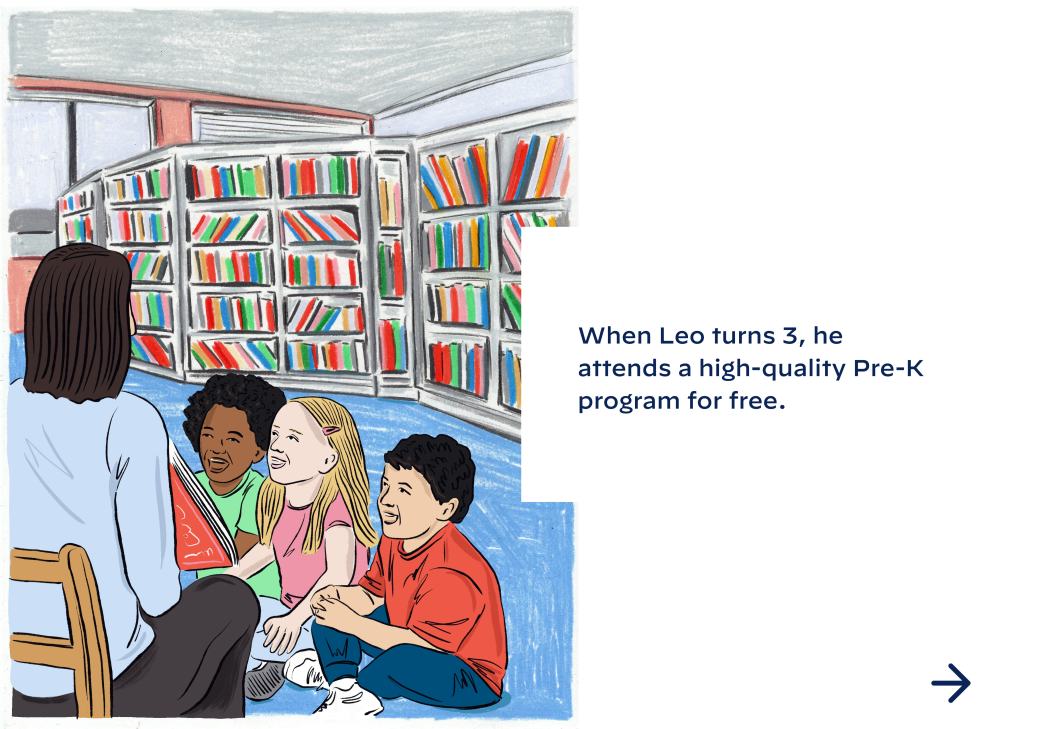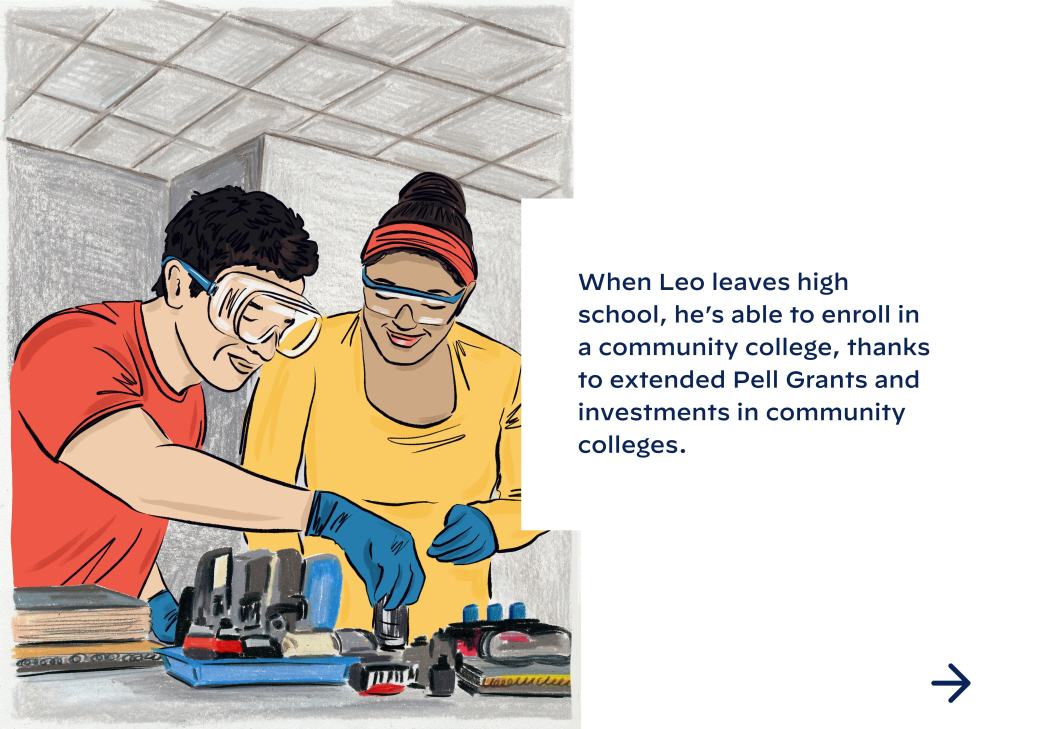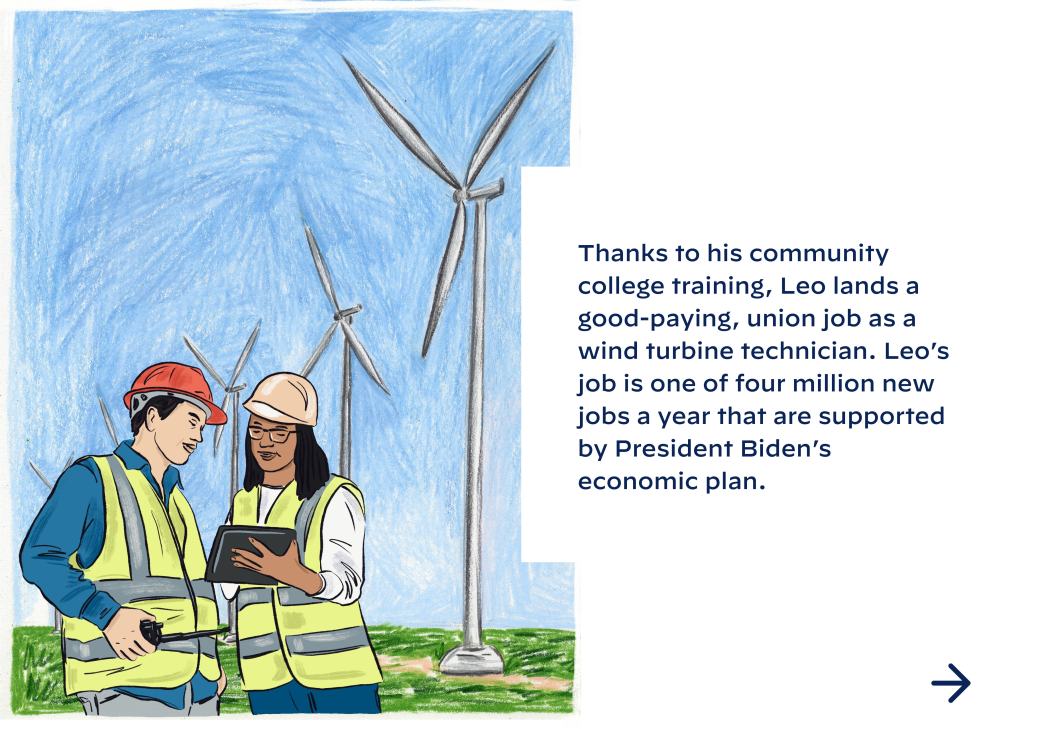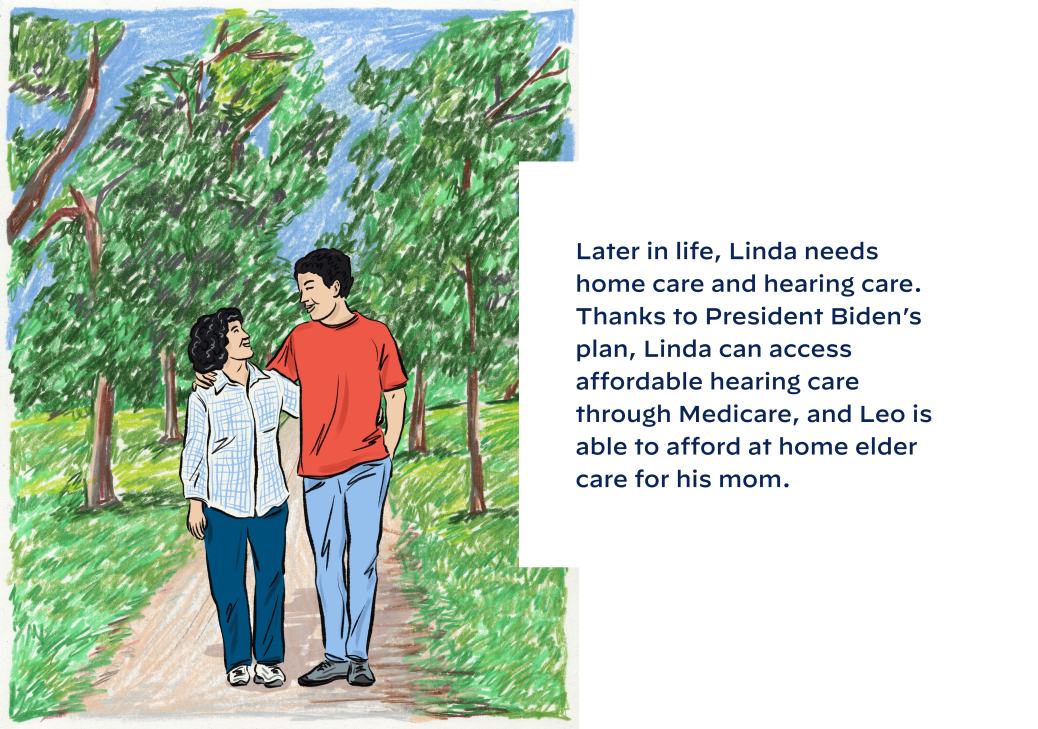The Build Back Better Framework
President Biden’s Plan to Rebuild the Middle Class
President Joe Biden believes that there’s no greater economic engine in the world than the hard work and ingenuity of the American people. But for too long, the economy has worked great for those at the top, while working families get squeezed. President Biden promised to rebuild the backbone of the country – the middle class – so that this time everyone comes along. The Build Back Better Framework does just that.
This framework will set the United States on course to meet its climate goals, create millions of good-paying jobs, enable more Americans to join and remain in the labor force, and grow our economy from the bottom up and the middle out.
Here’s what the Build Back Better Framework will mean for Linda from Peoria, IL:
Read more about the
Build Back Better Framework:
The most transformative investment in children and caregiving in generations:
Preschool in the United States costs about $8,600 per year. The Build Back Better framework will enable states to expand access to free preschool for more than 6 million children per year and increase the quality of preschool for many more children already enrolled. Importantly, parents will be able to send children to high-quality preschool in the setting of their choice – from public schools to child care providers to Head Start. The program will lead to lifelong educational and economic benefits for children and parents, and is a transformational investment in America’s future economic competitiveness. In fact, research shows that every $1 invested in high-quality early childhood care and education can yield $3 to $7 over the long-run, as they do better in school, are more likely to graduate high-school and college, and earn more as adults.
For decades, child care prices in the United States have risen faster than family incomes, yet the United States still invests 28 times less than its competitors on helping families afford high-quality care for toddlers. The Build Back Better framework will ensure that middle-class families pay no more than 7 percent of their income on child care and will help states expand access to high-quality, affordable child care to about 20 million children per year – covering 9 out of 10 families across the country with young children. For two parents with one toddler earning $100,000 per year, the framework will produce more than $5,000 in child care savings per year. Nearly all families of four making up to $300,000 per year will be eligible. And, better access to high-quality child care can increase the likelihood that parents, especially mothers, are employed or enrolled in education and training beyond high school, while also providing lifetime benefits for children, especially those who are economically disadvantaged.
Right now, there are hundreds of thousands of older Americans and Americans with disabilities are on waiting lists for home care services or struggling to afford the care they need, including more than 800,000 who are on state Medicaid waiting lists. A family paying for home care costs out of pocket currently pays around $5,800 per year for just four hours of home care per week. The Build Back Better framework will permanently improve Medicaid coverage for home care services for seniors and people with disabilities, making the most transformative investment in access to home care in 40 years, when these services were first authorized for Medicaid.
The Build Back Better framework will provide monthly payments to the parents of nearly 90 percent of American children for 2022 – $300 per month per child under six and $250 per month per child ages 6 to 17. This historic tax cut will help cover the cost of food, housing, health care, and transportation and will continue the largest one-year reduction in child poverty in history. And critically, the framework includes permanent refundability for the Child Tax Credit, meaning that the neediest families will continue to receive the full Child Tax Credit over the long-run.
The largest effort to combat climate change in American history:
The consumer rebates and credits included in the Build Back Better framework will save the average American family hundreds of dollars per year in energy costs. These measures include enhancement and expansion of existing home energy and efficiency tax credits, as well as the creation of a new, electrification-focused rebate program. The framework will cut the cost of installing rooftop solar for a home by around 30 percent, shortening the payback period by around 5 years; and the framework’s electric vehicle tax credit will lower the cost of an electric vehicle that is made in America with American materials and union labor by $12,500 for a middle-class family. In addition, the framework will help rural communities tap into the clean energy opportunity through targeted grants and loans through the Department of Agriculture.
The Build Back Better legislation will target incentives to grow domestic supply chains in solar, wind, and other critical industries in communities on the frontlines of the energy transition. In addition, the framework will boost the competitiveness of existing industries, like steel, cement, and aluminum, through grants, loans, tax credits, and procurement to drive capital investment in the decarbonization and revitalization of American manufacturing.
The framework will also fund port electrification; facilitate the deployment of cleaner transit, buses, and trucks; and support critical community capacity building, including grants to environmental justice communities. In addition, the framework will create a new Civilian Climate Corps – with over 300,000 members that look like America. This diverse new workforce will conserve our public lands, bolster community resilience, and address the changing climate, all while putting good-paying union jobs within reach for more Americans.
The framework will provide resources to farmers, ranchers, and forestland owners, supporting their efforts to reduce emissions. At its peak, the increased investments in climate smart agriculture alone could reach roughly 130 million cropland acres per year, representing as many as 240,000 farms. Farmers, ranchers, and forestland owners have long demonstrated leadership in environmental stewardship with strategies that provide benefits for the farm, the environment, and the public. These investments will help meet the demand from the farming community for conservation support and enable producers to realize the full potential of climate benefits from agriculture.
The biggest expansion of affordable health care in a decade:
Finally let Medicare negotiate drug prices.
Medicare will negotiate prices for high-cost prescription drugs. This will include drugs seniors get at the pharmacy counter (through Medicare Part D), and drugs that are administered in a doctor’s office (through Medicare Part B). Drugs become eligible for negotiation once they have been on the market for a fixed number of years: 9 years for small molecule drugs and 12 years for biologics. Medicare will negotiate up to 10 drugs per year during 2023, with those prices taking effect in 2025, increasing to up to 20 drugs per year.
The policy will establish a clearly defined negotiation process that is fair for manufacturers, and gets the biggest savings on drugs that have been on the market a long time. This discourages drug companies from abusing laws to prolong their monopolies, while encouraging investments in research and development of new cures. Drug companies that refuse to negotiate will owe an excise tax.
Impose a tax penalty if drug companies increase their prices faster than inflation. Starting when this bill becomes law, future drug price increases will be compared to their current prices. We will finally put an end to the days where drug companies could raise their prices with impunity. If prices for a drug increase faster than inflation, manufacturers will owe a tax penalty, holding down prices for Americans with all types of health insurance.
Directly lower out-of-pocket costs for seniors. Today, there is no cap on how much seniors and people with disabilities have to pay for drugs, and millions of seniors pay more than $6,000 a year in cost-sharing. This proposal puts an end to this burden, and ensures that seniors never pay more than $2,000 a year for their drugs under Medicare Part D.
The plan will also lower insulin prices so that Americans with diabetes don’t pay more than $35 per month for their insulin. Lawmakers have also agreed to lower seniors’ cost-sharing for all types of drugs and they are working expeditiously to finalize legislative text that will save seniors money at the pharmacy counter without increasing premiums.
The framework will reduce premiums for more than 9 million Americans who buy insurance through the Affordable Care Act Marketplace by an average of $600 per person per year. For example, a family of four earning $80,000 per year would save nearly $3,000 per year (or $246 per month) on health insurance premiums. Experts predict that more than 3 million people who would otherwise be uninsured will gain health insurance.
The Build Back Better framework will deliver health care coverage through Affordable Care Act premium tax credits to up to 4 million uninsured people in states that have locked them out of Medicaid through. A 40-year old in the coverage gap would have to pay $450 per month for benchmark coverage – more than half of their income in many cases. The framework provides individuals $0 premiums, finally making health care affordable and accessible.
The Build Back Better framework will expand Medicare coverage to cover hearing coverage, so that older Americans can access the affordable care they need.
The most significant effort to bring down costs and strengthen the middle class in generations:
The framework will enable the construction, rehabilitation, and improvement of more than 1 million affordable homes, boosting housing supply and reducing price pressures for renters and homeowners. It will address the capital needs of the public housing stock in big cities and rural communities all across America and ensure it is not only safe and habitable but healthier and more energy efficient as well. It will make a historic investment in rental assistance, expanding vouchers to hundreds of thousands of additional families. And, it includes one of the largest investments in down payment assistance in history, enabling hundreds of thousands of first-generation homebuyers to purchase their first home and build wealth. This legislation will create more equitable communities, through investing in community-led redevelopments projects in historically under-resourced neighborhoods and removing lead paint from hundreds of thousands of homes, as well as by incentivizing state and local zoning reforms that enable more families to reside in higher opportunity neighborhoods.
Before this year, the federal tax code taxed low-wage childless workers into poverty or deeper into poverty — the only group of workers it treated this way. The Build Back Better framework will extend the American Rescue Plan’s tripling of the credit for childless workers, benefiting 17 million low-wage workers, many of whom are essential workers, including cashiers, cooks, delivery drivers, food preparation workers, and childcare providers. For example, a childless worker who works 30 hours per week at $9 per hour earns income that, after taxes, leaves them below the federal poverty line. By increasing her EITC to more than $1,100, this EITC expansion helps pull such workers out of poverty.
Expand access to affordable, high-quality education beyond high school. Education beyond high school is increasingly important for economic growth and competitiveness in the 21st century, even as it has become unaffordable for too many families. The Build Back Better framework will make education beyond high school – including training for high-paying jobs available now – more affordable. Specifically, the framework will increase the maximum Pell Grant by $550 for more the more than 5 million students enrolled in public and private, non-profit colleges and expand access to DREAMers. It will also make historic investments in Historically Black Colleges and Universities (HBCUs), Tribal Colleges and Universities (TCUs), and minority-serving institutions (MSIs) to build capacity, modernize research infrastructure, and provide financial aid to low-income students. And, it will invest in practices that help more students complete their degree or credential. The framework will help more people access quality training that leads to good, union, and middle-class jobs. It will enable community colleges to train hundreds of thousands of students, create sector-based training opportunity with in- demand training for at least hundreds of thousands of workers, and invest in proven approaches like Registered Apprenticeships and programs to support underserved communities. The framework will increase the Labor Department’s annual spending on workforce development by 50% for each of the next 5 years.
The Build Back Better framework will help children reach their full potential by investing in nutrition security year-round. The legislation will expand free school meals to 8.7 million children during the school year and provide a $65 per child per month benefit to the families of 29 million children to purchase food during the summer.
The legislation makes a transformative investment in Rural America through a new Rural Partnership Program that will empower rural regions, including Tribal Nations and territories, by providing flexible funding for locally-led projects. The Build Back Better framework will provide nutrition security to millions of American children by expanding free school meals, which are the healthiest meals that children consume during the day. It also will make an historic investment in maternal health and establish a new and innovative community violence intervention initiative, in addition to investing in small businesses and preparing the nation for future pandemics and supply chain disruptions.
The framework includes a separate $100 billion investment in immigration reform that is consistent with the Senate’s reconciliation rules, as well as enhancements to reduce backlogs, expand legal representation, and make the asylum system and border processing more efficient and humane.
The Build Back Better framework is fully paid for:
Combined with savings from repealing the Trump Administration’s rebate rule, the plan is fully paid for by asking more from the very largest corporations and the wealthiest Americans. The 2017 tax cut delivered a windfall to them, and this would help reverse that—and invest in the country’s future. No one making under $400,000 will pay a penny more in taxes.
Specifically, the framework:
In 2019, the largest corporations in the United States paid just 8 percent in taxes, and many paid nothing at all. President Biden believes this is fundamentally unfair. The Build Back Better framework will impose a 15% minimum tax on the corporate profits that large corporations—with over $1 billion in profits—report to shareholders. This means that if a large corporation says it’s profitable, then it can’t avoid paying its tax bill. The framework also includes a 1% surcharge on corporate stock buybacks, which corporate executives too often use to enrich themselves rather than investing workers and growing the economy.
President Biden has led the world to stop the race to the bottom in corporate taxes and that rewards corporations that ship jobs and profits overseas. That’s why the President won an agreement among 136 countries on a 15% global minimum tax. This framework would help finish the job. Consistent with that agreement, it’d adopt a 15% minimum tax on foreign profits of U.S. corporations, so that they can no longer claim huge tax benefits by shifting profits and jobs abroad. And, it’d make sure that other countries abide by the agreement they adopted by imposing a penalty rate on any foreign corporations based in countries that fail to abide by the international agreement. Other countries will not be able to try to take advantage by failing to meet their commitment.
The Build Back Better framework includes a new surtax on the income of multi-millionaires and billionaires – the top 0.02 percent of Americans. It would apply a 5 percent rate above income of $10 million, and an additional 3 percent above income of $25 million. The Build Back Better framework will also close the loopholes that allows some wealthy taxpayers to avoid paying the 3.8 Medicare tax on their earnings.
Regular workers pay the taxes they owe on wages and salaries—with a 99 percent compliance rate—while too many wealthy taxpayers hide their income from the IRS so they don’t have to pay. And, as a result of budget cuts, audit rates on those making over $1 million per year fell by 80 percent between 2011-2018. Wage earners have a 99 percent compliance rate, and, by contrast, the top 1 percent evades over $160 billion per year in taxes. President Biden’s Build Back Better Agenda will create a fairer tax system – a tax system that requires the wealthy to finally pay their fair share and rewards work, not wealth. The President’s plan will accomplish this through transformation investments in the IRS: hiring enforcement agents who are trained to pursue wealthy evaders, overhauling technology from the 1960s, and investing in taxpayer service, so ordinary Americans can get their questions answered. Additional enforcement resources will be focused on pursuing those with the highest incomes; not Americans with income less than $400,000.


